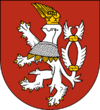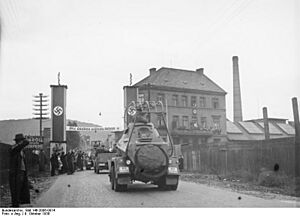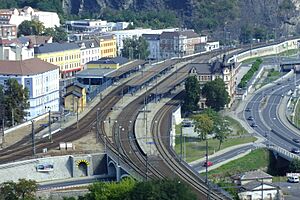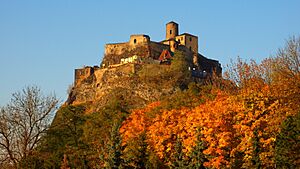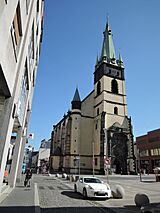Ústí nad Labem facts for kids
Quick facts for kids
Ústí nad Labem
|
|||
|---|---|---|---|
|
Statutory city
|
|||

From top: city centre view, Mariánský most, city spa, city hall, Střekov Castle, Míru Square
|
|||
|
|||
| Country | |||
| Region | Ústí nad Labem | ||
| District | Ústí nad Labem | ||
| First mentioned | 1056–1057 | ||
| Area | |||
| • Total | 93.97 km2 (36.28 sq mi) | ||
| Elevation | 218 m (715 ft) | ||
| Population
(2024-01-01)
|
|||
| • Total | 91,342 | ||
| • Density | 972.03/km2 (2,517.56/sq mi) | ||
| Time zone | UTC+1 (CET) | ||
| • Summer (DST) | UTC+2 (CEST) | ||
| Postal codes |
400 01 – 400 03, 400 07, 400 10, 400 11, 403 02, 403 21, 403 22, 403 31, 403 40
|
||
Ústí nad Labem (pronounced OOS-tee nahd LAH-bem) is a city in the Czech Republic. It has about 91,000 people living there. It is the main city of the Ústí nad Labem Region. The city is a big industrial center. It is also an important river port and a major railway hub.
Contents
- City Parts and Divisions
- What Does the Name Ústí nad Labem Mean?
- Geography and Landscape
- History of Ústí nad Labem
- Population Changes Over Time
- Economy and Jobs
- Transportation in the City
- Education Opportunities
- Sports in Ústí nad Labem
- Places to See
- Famous People from Ústí nad Labem
- Sister Cities
- Images for kids
- See also
City Parts and Divisions
Ústí nad Labem is split into four main areas. These areas are then divided into 22 smaller parts. This helps manage the city better.
What Does the Name Ústí nad Labem Mean?
The name Ústí nad Labem comes from old Czech words. Ustie means "river mouth" and Labe is the Elbe River. So, the name literally means "Mouth-upon-the-Elbe." This is because the city is located where the Bílina River flows into the Elbe River.
Before the Czech Republic became independent, the city was often called Aussig in English. This was the German name for the city.
Geography and Landscape
Ústí nad Labem is located about 65 kilometers (40 miles) north of Prague. It is also about 45 kilometers (28 miles) south of Dresden in Germany. The city is mostly in a hilly area called the Central Bohemian Uplands. However, it also stretches into a flatter area in the northwest.
The highest point nearby is Široký vrch hill, which is 659 meters (2,162 feet) above sea level. The city sits where the Elbe and Bílina rivers meet. Part of Lake Milada is also within the city's area. The southern part of the city is in a protected nature area.
Climate in Ústí nad Labem
| Climate data for Ústí nad Labem, 1991–2020 normals, extremes 1975–present | |||||||||||||
|---|---|---|---|---|---|---|---|---|---|---|---|---|---|
| Month | Jan | Feb | Mar | Apr | May | Jun | Jul | Aug | Sep | Oct | Nov | Dec | Year |
| Record high °C (°F) | 15.9 (60.6) |
16.3 (61.3) |
23.1 (73.6) |
27.5 (81.5) |
29.8 (85.6) |
36.7 (98.1) |
36.0 (96.8) |
36.6 (97.9) |
31.1 (88.0) |
25.4 (77.7) |
17.0 (62.6) |
15.4 (59.7) |
36.6 (97.9) |
| Mean daily maximum °C (°F) | 1.3 (34.3) |
3.1 (37.6) |
7.6 (45.7) |
14.1 (57.4) |
18.5 (65.3) |
21.7 (71.1) |
23.9 (75.0) |
23.9 (75.0) |
18.6 (65.5) |
12.2 (54.0) |
6.0 (42.8) |
2.1 (35.8) |
12.7 (54.9) |
| Daily mean °C (°F) | −1.2 (29.8) |
0.1 (32.2) |
3.7 (38.7) |
9.1 (48.4) |
13.3 (55.9) |
16.4 (61.5) |
18.4 (65.1) |
18.1 (64.6) |
13.5 (56.3) |
8.4 (47.1) |
3.4 (38.1) |
−0.2 (31.6) |
8.6 (47.5) |
| Mean daily minimum °C (°F) | −3.2 (26.2) |
−2.4 (27.7) |
0.6 (33.1) |
5.0 (41.0) |
8.8 (47.8) |
11.9 (53.4) |
13.9 (57.0) |
13.7 (56.7) |
9.9 (49.8) |
5.7 (42.3) |
1.5 (34.7) |
−2.1 (28.2) |
5.3 (41.5) |
| Record low °C (°F) | −22.1 (−7.8) |
−19.5 (−3.1) |
−14.0 (6.8) |
−7.1 (19.2) |
−3.2 (26.2) |
2.4 (36.3) |
6.4 (43.5) |
5.2 (41.4) |
1.2 (34.2) |
−4.8 (23.4) |
−12.0 (10.4) |
−18.5 (−1.3) |
−22.1 (−7.8) |
| Average precipitation mm (inches) | 42.4 (1.67) |
33.3 (1.31) |
33.7 (1.33) |
31.9 (1.26) |
59.2 (2.33) |
72.4 (2.85) |
81.2 (3.20) |
77.5 (3.05) |
49.1 (1.93) |
45.5 (1.79) |
42.5 (1.67) |
44.8 (1.76) |
613.5 (24.15) |
| Average snowfall cm (inches) | 20.1 (7.9) |
16.9 (6.7) |
9.2 (3.6) |
1.7 (0.7) |
0.0 (0.0) |
0.0 (0.0) |
0.0 (0.0) |
0.0 (0.0) |
0.0 (0.0) |
0.5 (0.2) |
6.9 (2.7) |
17.4 (6.9) |
72.6 (28.6) |
| Average precipitation days (≥ 1.0 mm) | 11.1 | 8.3 | 8.1 | 6.8 | 9.3 | 9.9 | 10.6 | 9.2 | 8.2 | 8.9 | 9.3 | 10.6 | 110.2 |
| Average relative humidity (%) | 84.0 | 78.2 | 72.1 | 63.6 | 65.3 | 66.3 | 65.5 | 66.4 | 73.1 | 80.2 | 86.0 | 86.1 | 73.9 |
| Mean monthly sunshine hours | 36.4 | 65.7 | 110.3 | 174.5 | 212.3 | 213.6 | 224.2 | 215.9 | 146.8 | 88.1 | 38.8 | 30.1 | 1,556.6 |
| Source 1: NOAA | |||||||||||||
| Source 2: Czech Hydrometeorological Institute | |||||||||||||
History of Ústí nad Labem
The city was first mentioned in writing around 1056 or 1057. In 1249, it was officially called a "royal town." This meant it had special rights from the king.
In the late 1200s, King Ottokar II of Bohemia invited German settlers to the area. They helped build the city. In 1426, the city was attacked by the Hussites, a religious group. A large German army tried to help, but the Hussites won. They then destroyed the town. It was rebuilt three years later.
Ústí nad Labem suffered a lot in later wars. It was burned down in 1583 and attacked by the Swedes in 1639 during the Thirty Years' War. It also faced hardship during the Seven Years' War and the Napoleonic Wars. By 1830, only about 1,400 people lived there.
Growth and Industry
In the 1800s, Ústí nad Labem became part of Austria. It grew a lot during the Industrial Revolution. By the 1870s, it was making many products like wool, linen, paper, and chemicals. It also traded a lot of grain, fruit, and coal. The city's river port became the busiest in the entire Austro-Hungarian Empire.
World War II and After
Before World War II, many people in Ústí nad Labem were German. In 1938, the city became part of Nazi Germany. This happened under an agreement called the Munich Agreement. On New Year's Eve of that year, the local synagogue was burned down. The Jewish community faced terrible times during World War II. Many were killed in the the Holocaust. In April 1945, the city was heavily bombed by the Allies.
After the war, in July 1945, an explosion at a local ammunition depot caused unrest. This led to many German residents being forced to leave the city. This event is known as the Ústí massacre. The city was then returned to Czechoslovakia.
Later, a Communist government took over. This lasted until 1989, when the Velvet Revolution brought big changes. Today, Ústí nad Labem is a major industrial city in the Czech Republic. It has important chemical, metal, textile, food, and machine industries.
The Matiční Street Wall
In the late 1990s, Ústí nad Labem became known for a wall built on Matiční Street. This wall was about 150 meters (490 feet) long. It separated houses on one side from apartment buildings on the other. Many Romani families lived in the apartment buildings.
This wall caused a big international discussion. City officials said the wall was to reduce noise and rubbish, not to separate people by race. However, many groups and foreign observers called it "racist." They said it was a way to segregate people.
Despite the opposition, the wall was completed in October 1999. But because of strong pressure from within the Czech Republic and from other countries, the city decided to take it down. The wall was demolished just six weeks after it was built. Today, parts of the ceramic fence are used at the local zoo. Matiční Street is now empty, and its buildings are planned to be torn down.
Population Changes Over Time
| Historical population | ||||||||||||||||||||||||||||||||||||||||||||||||||||||||
|---|---|---|---|---|---|---|---|---|---|---|---|---|---|---|---|---|---|---|---|---|---|---|---|---|---|---|---|---|---|---|---|---|---|---|---|---|---|---|---|---|---|---|---|---|---|---|---|---|---|---|---|---|---|---|---|---|
|
|
|
||||||||||||||||||||||||||||||||||||||||||||||||||||||
| Source: Censuses | ||||||||||||||||||||||||||||||||||||||||||||||||||||||||
Economy and Jobs
Ústí nad Labem is the main economic hub for its region. Many industrial companies have their headquarters here. Some of the largest employers include Spolek pro chemickou a hutní výrobu (a chemical company) and Strabag Rail (a construction company). Other big companies make elevators, print things, and produce car parts.
Transportation in the City
Ústí nad Labem has many ways to get around, making it an important transport center.
Road Travel
The D8 motorway connects Prague to Dresden in Germany. This major highway passes by Ústí nad Labem. Another important road, the European route E442, goes through the city, connecting Liberec and Karlovy Vary.
The Mariánský Bridge is a beautiful road bridge over the Elbe River. It was finished in 1998 and is one of the city's main landmarks. It was even named one of the 10 best structures in the world by an international engineering group.
City Public Transport
The city has a good public transport system. It includes both buses and trolley bus lines. The city has its own company that runs these services.
Train Travel
Ústí nad Labem is a very important place for trains. It has four railway stations. The main station, Ústí nad Labem main railway station, is used by international trains. You can take a train directly from Ústí nad Labem to cities like Berlin, Budapest, and Zürich. There are also important national train lines that pass through the city.
River Travel
The Elbe River is a major waterway. It connects Ústí nad Labem to other rivers in Western Europe. This allows access to Germany, the Netherlands, Belgium, Luxembourg, northern France, and important seaports. Both cargo and pleasure boats use the river.
Air Travel
There is a small airport for sports planes near the city. For bigger planes, the closest airports are Prague Airport (64 km or 40 miles away) and Dresden Airport in Germany (56 km or 35 miles away).
Education Opportunities
Ústí nad Labem is home to the Jan Evangelista Purkyně University in Ústí nad Labem. This public university has about 8,500 students. With around 900 employees, it is one of the biggest employers in the region.
Sports in Ústí nad Labem
The city has a local ice hockey team called HC Slovan Ústečtí Lvi. There is also a football club, FK Viagem Ústí nad Labem, which plays at the Municipal Stadium.
Ústí nad Labem also hosts the Ústí nad Labem Half Marathon. This is a big running event that is part of the World Athletics Label Road Races.
In the past, the city also had a successful motorcycle speedway team. They won several medals in the Czechoslovak Championship.
Places to See
The Střekov Castle is one of the most famous sights in Ústí nad Labem. It is also one of the most visited places in the whole region. The castle was built between 1316 and 1319. It has been owned by the Lobkowicz family since 1563.
The Church of the Assumption of the Virgin Mary was built in 1318. It is in the city center and is famous for its leaning tower. The tower is 65 meters (213 feet) high. It leans by 201 centimeters (6 feet 7 inches) because of bombing during World War II. It is the most leaning tower north of the Alps.
Another important landmark is Větruše hill. It has an observation tower and the Větruše Castle. The castle was built in 1847 as a hotel and restaurant.
In the Krásné Březno part of the city, you can find the Ústí nad Labem Zoo. It was started in 1908. The Krásné Březno Castle is also notable. It has an Old Castle (built before 1568) and a New Castle (built in the early 1600s). The castle is surrounded by a beautiful English park. Today, the castle is used by the National Heritage Institute of the Czech Republic.
Famous People from Ústí nad Labem
- Anton Raphael Mengs (1728–1779), German painter
- Felix Weinberg (1928–2012), Czech-British physicist
- Günther Herbig (born 1931), German conductor
- Vladimír Páral (born 1932), writer
- Heinz Edelmann (1934–2009), Czech-German illustrator and designer
- Milan Hejduk (born 1976), ice hockey player
- Jiří Jarošík (born 1977), footballer
- Petra Gelbart (born 1978), musicologist, musician, music therapist and human rights defender
- Jan Mertl (born 1982), tennis coach and player
- Tomáš Černý (born 1985), footballer
- Michal Neuvirth (born 1988), ice hockey player
Sister Cities
Ústí nad Labem has "sister city" relationships with other cities. This helps them share culture and ideas.
The city also works closely with Dresden, Germany.
Images for kids
See also
 In Spanish: Ústí nad Labem para niños
In Spanish: Ústí nad Labem para niños



